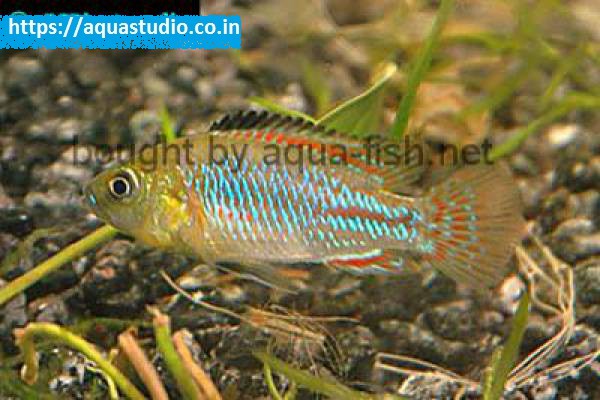Scientific name: Pseudocrenilabrus nicholsi Common name: Nichols’ dwarf mouthbrooder Family: Cichlidae Usual size in fish tanks: 8 - 9 cm (3.15 - 3.54 inch) 0 14 Recommended pH range for the species: 6 - 8 Recommended water hardness (dGH): 8 - 18°N (142.86 - 321.43ppm) 0°C 32°F 30°C 86°F Recommended temperature: 22 - 25 °C (71.6 - 77°F) The way how these fish reproduce: Spawning Where the species comes from: Africa Temperament to its own species: peaceful Temperament toward other fish species: aggressive to smaller Usual place in the tank: Bottom levels Origin The Nichol’s dwarf mouthbrooder can be found in Africa, namely the Democratic Republic of Congo. It can be found in small rivers with slow moving waters and many local ponds. Short description Although this species is not all that common in the aquarium trade if you can find them they make a great addition to the aquarium and display a wonderful colouration. They belong to the family of cichlids and can become quite territorial especially at spawning times so bear this in mind when stocking. Adult specimens will reach an average length of 3.5 inches making them ideal for medium sized aquariums and males will display light blue scales on top of a pale gold background colour. Bear in mind that makes will become highly territorial and aggressive to one another so it is best to keep a single male with several females. Lifespan If cared for correctly, the average lifespan for Nichol’s dwarf mouthbrooder is expected to be between 6-7 years. General care Not a difficult species to care for but they do like high water quality in the aquarium. The minimum sized aquarium should be at least 36 inches in length (90 cm) and 12 inches deep (30 cm). Always use a filtration system rated for the water volume that the aquarium holds. The temperature range should be set between 22-25°C (72 -77°F) and keep the pH between 6.0-8.0. Sand or fine gravel should be used for the substrate and add hiding places with the use of rocks, wood or suitable ornaments. Plants can be added and they will not be harmed by these fish. Perform regular water changes, at least 10% weekly as like all cichlids Nichol’s mouthbrooders can be high waste producers. They tend to inhabit the lower levels of the aquarium so suitable tankmates are species that prefer the mid to higher levels such as tetras or rasboras. Feeding Nichol’s dwarf mouthbrooder are classed as omnivorous so will require a mixed diet to keep them at their best. For the staple diet offer small cichlid pellets or a quality commercial flake but this will need to be varied with regular feedings of live or frozen foods. Brine shrimp, bloodworms and daphnia are ideal. You can also offer extra vegetable matter in the form of blanched peas or chopped cucumber. Sexing Mature males will grow slightly larger than mature females and will display a brighter colouration. Some male specimens may also develop extended finnage but not all. Breeding As you can see from their common name, they are a mouth brooding species and it is the female that holds the eggs and fry when they hatch. It is best to use a separate breeding tank and you will need several females to add to the tank with one male. They are not difficult to get to breed but it will help if you condition the parent fish on meaty foods for a couple of weeks prior to spawning. This will also help to build up strength in the female fish. The male will prepare a nest in the substrate by digging out a pit and then he will try to entice the female over to deposit her eggs. The male will display to the females and when a female is ready to spawn she will swim over to the pit and the male will nudge her to encourage the eggs to be laid. Once the eggs are laid the female will scoop them into her mouth and then swim to the male and hold her mouth near his vent so that he can release the milt which is then also scooped into her mouth for fertilisation. The eggs will take approximately 10 days to incubate the eggs and to hold the fry until they are free swimming, at this point she will release them so that they can feed. Once the fry are released they can be fed on newly hatched brine shrimp, or a commercial egg layer fry food until they are large enough to digest the same food as their parents. The female should be rested for at least 3 weeks before you attempt to use her for breeding purposes so that she can regain her full strength. Pictures Bought by aqua-fish.net from jjphoto.dk.
